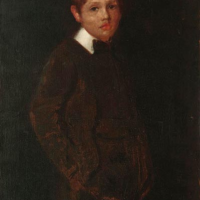54. TOM ROBERTS

Tom Roberts is lauded for his iconic paintings of Australian cities, rural labour and the bush, but he is also an acclaimed portraitist. Among the many commissioned portraits of society women and men is a stand out group of sensitive depictions of his immediate family. These treasured works provide a tantalising glimpse into the artists private world and his undoubted love and affection for his wife and son.
Tom, Lillie and five-year-old Caleb arrived in England in April 1903. According to academic John Richards, in a fascinating essay on Robertss London years, they took lodgings in Manchester Square, later in the year moving to a flat in Putney. Although he had rented a studio in Warwick Square, the Imperial Institute also gave him the use of its South Africa Room, a big space for painting with high north-facing windows, a room to dream in as he described it.1
Tom Roberts returned to England to make his mark on the art world. He was there to make portrait studies of notable dignitaries, including members of the English royal family, to feature in his Big Picture a challenging and sometimes frustrating magnum opus commissioned to celebrate the opening of the Australian parliament in 1901.2 This was a difficult period in Robertss life that culminated in a ceremony on 4 July 1904 at the Royal Academy, London, where the enormous painting was put on display.
Works such as the delightful portrait of Caleb, currently on offer, must have been a welcome diversion for Roberts after the exacting process and stiff formality of the Big Picture. Painted two years after their arrival in London, Portrait of the artists son, Caleb, c.1905, is one of a number of intriguing works that Roberts based on his only son, each one as fresh and insightful as the other.
One of these portraits recently came to light on the occasion of the major Tom Roberts Retrospective held at the National Gallery of Australia. Hidden from public view for years, this rare pastel sketch captures the hearty cry and bellowing lungs of a child captured mid-sob. Roberts made the sketch in 1898 as a study for a larger portrait, which also has only rarely been on public display.3
The intimacy of the earlier drawings and paintings of Caleb often featuring the endearing and wide-eyed innocence of early childhood develops into a growing air of self-confidence in the c.1905 paintings of Caleb. Although only seven or eight, one can see this transition most clearly in a comparison of the present work with a painting of Caleb once held in a Western Australian private collection.4
In the smaller Western Australian work the focus is clearly on the boys head and facial expression. Calebs face is cocked pliantly to the side, his eyes bright and wide and hair groomed and parted in a way that implies the intercession of an adult. Portrait of the artists son, Caleb, on the other hand, is a more assured and individualised study of a rapidly maturing boy. He now wears the suave trappings of a private school education, hands are placed casually in a pocket while his body sways forward in an adult-like gait. Caleb stares directly at the viewer and his hair is slightly unkempt. In this painting he is being characterised by Tom Roberts as an emerging young man; he is literally growing before the artists eyes.
One of Australias greatest landscape painters and a purveyor of the masculinist manual labour traditions of the 1880s and 90s in art, Tom Robertss portraits of women and children drew steady acclaim during the time in which they were produced and far beyond. They are sensitive and thoughtful characterisations of their respective sitters and nowhere is this more obvious than in the portraits of Lillie and Caleb. After all, who better than Tom Roberts to record the coming of age of his own son?
Footnotes
1. Rickard, J., Tom Roberts London years, Australians in Britain: The Twentieth-Century Experience, edited by Bridge, Carl; Crawford, Robert; Dunstan, David, Melbourne: Monash University ePress, 2009. pp. 5.1 to 5.13.
2. Tom Roberts, Opening of the First Parliament of the Commonwealth of Australia by H.R.H. The Duke of Cornwall and York (Later King George V), May 9, 1901, 1903, oil on canvas, on permanent loan to the Parliament of Australia from the British Royal Collection.
3. Prior, S., Tom Roberts' great-granddaughter donates painting to National Gallery of Australia, Sydney Morning Herald, 25 January 2016.
4. Topliss, H., Tom Roberts: A catalogue Raisonn, Oxford University Press, Melbourne, 1985. Reproduced in Pamela Clelland Gray, A pioneer of Australian picture framing: an introduction to the work of Lillie Williamson, Art Bulletin of Victoria, National Gallery of Victoria, 1994.
Rodney James BA (Hons); MA